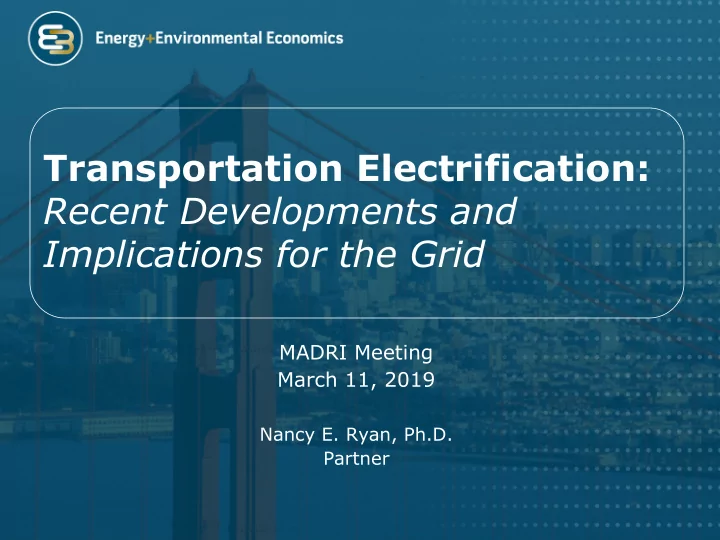

Transportation Electrification: Recent Developments and Implications for the Grid MADRI Meeting March 11, 2019 Nancy E. Ryan, Ph.D. Partner
About Energy and Environmental Economics, Inc. (E3) Founded in 1989, E3 is an industry leading consultancy in North America with a growing international presence E3’s 50+ consultants operate at the nexus of energy and environmental economics, regulation and public policy Our team employs a unique combination of economic analysis, modeling acumen, and deep institutional insight to solve complex problems and provide thought leadership for a diverse client base State Agencies Utilities Regulatory Authorities System Operators State Executive Branches Financial Institutions Legislators Consumer Advocates Project Developers Environmental Technology Companies Interests Asset Owners Energy Consumers Financiers/Investors 2
Outline of presentation Update on state of EV technology and key trends Characteristics of EV charging loads and implications for the grid Results from selected studies on distribution grid upgrade costs What’s next? 3
Automakers are committing to EVs on a global basis 4 4
The purchase price premium for EVs is declining with battery costs Source: https://about.bnef.com/electric-vehicle-outlook/ 5
Vehicle buyers will soon have many ZEV options EV Vehicle Models Available (2010-22) 6 6 Source: https://www.epri.com/#/pages/summary/000000003002013754/?lang=en
Medium and Heavy Duty segments are transforming also Here Today Coming Tomorrow 7
Timing of battery electric vehicle cost parity with diesel counterparts *Source: https://www.mckinsey.com/industries/automotive-and-assembly/our-insights/whats-sparking-electric-vehicle-adoption-in-the-truck-industry 8
Technologies and policies are developing to support vehicle-grid integration (VGI) ‘Smart’ charging (or ‘V1G’) through targeted utility tariffs or communication from grid operator to aggregator / vehicle V2G capability allows PEV to V2H/V2B/V2X capability can discharge to grid, receive payment for enhance PEV value proposition services 9
Grid integration measures: Smart Charging (V1G) Rate design: Washington DC San Diego (No Time Varying Rates) (TOU Rates) • Time of use (TOU) rates vary on a fixed schedule and are higher during periods of peak demand on the bulk power system. • Dynamic rates vary from hour to hour with conditions on the bulk system or local grid (SDG&E’s Charge Ready Pilot) Demand response: • The utility or a third party directly controls when and even where a vehicle charges: PG&E/BMW pilot • Customer is paid for performance and can over-ride if desired. • Aggregator may employ stationary battery backup to assure performance.
Distribution grid impacts of EV Adoption in the SF Bay Area Feeder and substation utilization with “ZEV most likely” vehicle adoption and TOU rates 2010 2020 2030 http://caletc.com/wp-content/uploads/2016/08/CalETC_TEA_Phase_2_Final_10-23-14.pdf 11
NYSERDA Cost Benefit Analysis of LDV Electrification in New York Societal Benefits on Long Island, Base Case eVMT Savings 16,000 1,921 Avoided 14,000 Vehicle O&M 12,000 17% NPV $/Vehicle 10,000 Gasoline Security Avoided 8,000 Value Gasoline 11% 72% 6,000 4,000 Electricity Supply Costs 2,000 0 AS 1% Costs Benefits Losses 4% Gen. Tax Credits Net Benefi Net Benefit Capacity Energy 7% 69% eVMT Savings Incr. Vehicle Cost Incr. Vehic T&D Emissions Electricity Electricity Supply Capacity Charging I 19% 12 ng Infrastructure
Avoided T&D costs drive savings from smart charging in New York study 13
Three transportation revolutions present new challenges
Coming soon: Ultrafast DCFC Charging Plazas A load as big as a Walmart in the footprint of a 7-11 15
Three Revolutions: Dream Scenario DREAM 16
Three Revolutions: Nightmare Scenario NIGHTMARE 17
THANK YOU Nancy E. Ryan, Ph.D. Partner nancy.ryan@ethree.com 415-391-5100 www.ethree.com 18
Specs: Electric Delivery Vans (Class 5) Charging: conductive, plug-in • Level 2 (J1772) and DC fast charging capable • Level 2: overnight charge • DC fast charging: 80% charge in ~1 hour • Battery packs: 60-100 kWh Manufacturers: Workhorse, Chanje 19
Specs: Parcel Trucks (Class 6) Charging: conductive, plug-in • Level 2 (J1772) and DC fast charging capable • Battery packs: 70-120 kWh Manufacturers: Workhorse, Boulder Electric, Thor 20
Electric Bus Specs Charging options: • Conductive (plug-in): Level 2, DC fast charging, and pantographs • Inductive (wireless): limited commercial availability; most expensive option and remains largely in pilot phase • Battery packs: ~60 – 600 kWh (current best in class is 400 – 600 kWh depending on manufacturer) Many manufacturers: • Transit : BYD, Proterra, Solaris, VDL, Optare, Volvo, Van Hool, and many high-volume manufacturers supplying the Chinese market • Transit bus manufacturing volume is dominated by Chinese firms, but competition from US and European manufacturers is growing. • School : Lion, Blue Bird, Green Power, Starcraft, Trans Tech 21
E-bus Charging Technologies Coils under road surface Slow charger: 15-22 kW, Direct electrical transfer energy to coils full charge in ~10h connection, without plug beneath bus floor • 2:1 bus-to-charger ratio • 20:1 bus-to-charger Power output up to 200 kW Fast (22-50 kW) and ratio Rapid (50-120 kW) Stationary systems (bus 150-300 kW power chargers: full charge in positioned over coils) output 2-6h commercially available today Offered by many e- • 20:1 bus-to-charger ratio • 20:1 bus-to-charger ratio bus providers (e.g., Most common for Dynamic systems (bus Proterra, Solaris, overnight or layover charged while in motion) VDL, Volvo, Van charging remain in pilot / demo stage Hool) Source and Image: Bloomberg New Energy Finance 22
Challenges and Opportunities Challenges • Including charges, electric buses have upfront premium of ~$300,000 over diesel buses (which typically cost $450,000 – 750,000) • Existing commercial and industrial rates may not currently be suitable for early state deployment of electric buses, which can significantly impact customer bills • Bus loads can be 100 kW – 500 kW, depending on charger type Opportunities • School buses provide a unique opportunity to create a day- time load • Large batteries of ~200kWh are also potential sources of ancillary services 23
Recommend
More recommend